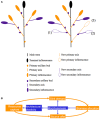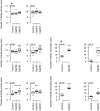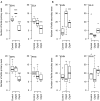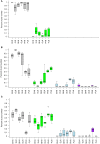Floral bud damage compensation by branching and biomass allocation in genotypes of Brassica napus with different architecture and branching potential
- PMID: 25759703
- PMCID: PMC4338677
- DOI: 10.3389/fpls.2015.00070
Floral bud damage compensation by branching and biomass allocation in genotypes of Brassica napus with different architecture and branching potential
Abstract
Plant branching is a key process in the yield elaboration of winter oilseed rape (WOSR). It is also involved in plant tolerance to flower damage because it allows the setting of new fertile inflorescences. Here we characterize the changes in the branching and distribution of the number of pods between primary and secondary inflorescences in response to floral bud clippings. Then we investigate the impacts of the modifications in branching on the biomass allocation and its consequence on the crop productivity (harvest index). These issues were addressed on plants with contrasted architecture and branching potential, using three genotypes (Exocet, Pollen, and Gamin) grown under two levels of nitrogen fertilization. Clipping treatments of increasing intensities were applied to either inflorescences or flower buds. We were able to show that restoration of the number of pods after clipping is the main lever for the compensation. Genotypes presented different behaviors in branching and biomass allocation as a function of clipping treatments. The number of fertile ramifications increased for the high intensities of clipping. In particular, the growth of secondary ramifications carried by branches developed before clipping has been observed. The proportions of yield and of number of pods carried by these secondary axes increased and became almost equivalent to the proportion carried by primary inflorescences. In terms of biomass allocation, variations have also been evidenced in the relationship between pod dry mass on a given axis and the number of pods set, while the shoot/root ratio was not modified. The harvest index presented different responses: it decreased after flower buds clipping, while it was maintained after the clipping of the whole inflorescences. The results are discussed relative to their implications regarding the identification of interesting traits to be target in breeding programs in order to improve WOSR tolerance.
Keywords: Brassica napus; allometry; architecture; biomass allocation; harvest index; plant resilience; plasticity; winter oilseed rape.
Figures






References
-
- Allirand J.-M., Jullien A., Mathieu A., Bregeon M., Pinet A., Lafouge F., et al. (2011). The importance of branching and branches characteristics on oilseed rape genotype x nitrogen interactions, in 13th International Rapeseed Congress, International Consultative Research Group on Rapeseed, Prague (CSK), 2011/06/05-09. 377–381 Available online at: http://www.irc2011.org
-
- Annisa, Chen S., Turner N. C., Cowling W. A. (2013). Genetic variation for heat tolerance during the reproductive phase in Brassica rapa. J. Agron. Crop. Sci. 199, 424–435 10.1111/jac.12034 - DOI
LinkOut - more resources
Full Text Sources
Other Literature Sources

